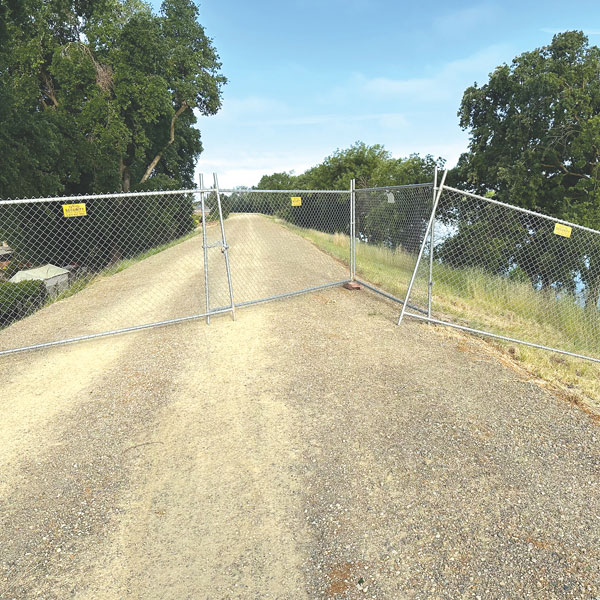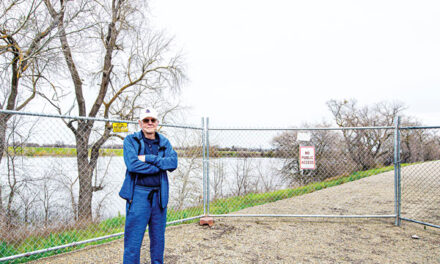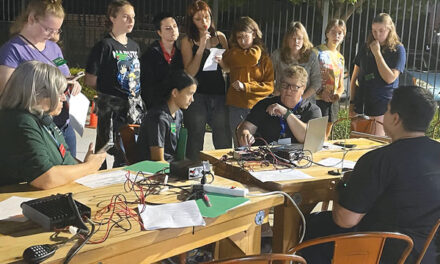Temporary chain-link fences showed up overnight. Stretched across the Sacramento River levee, blocking the gravel path, disheveled and lurching like drunks after a party. One fence ran into the water, breaking federal and state laws.
Somehow, the fences were approved by state officials from the Central Valley Flood Protection Board.
In May, a staff member at Central Valley Flood issued temporary permits for two private, cross-levee fences and gates in Pocket. The new barricades went up fast.
They were erected by property owners near the river, the small, loud group that spent years fighting to keep the public away from the levee.

The question is why this happened.
For nearly a decade, Central Valley Flood Protection Board members indicated they would remove nine fences that blocked the levee since the 1970s. Central Valley Flood owns the levees and controls activities there.
Fence removals started in 2019, when Army Corps of Engineers contractors began the levee reconstruction project.
The public cheered when the fences fell. Levee access became a reality. The east bank of the Sacramento River is a beautiful natural resource. It belongs to everyone, not a handful of homesteaders who happen to live nearby.
Also cheering was the California Department of Water Resources. The agency opposes private gates and fences across the levee. Barricades hinder maintenance and flood-fighting capabilities.
The city of Sacramento wanted the fences gone. In 1975, city officials promised the community a parkway and bike path along the levee from Miller Park to Freeport. Engineering work for the trail is finally underway.
No public agency supports private fences across the levee. The public despises them. Yet here we are with two new
haphazard, dangerous fences.
Jim Geary, a lawyer who has worked decades to get the river parkway built, drove to Central Valley Flood headquarters on El Camino Avenue when he saw the new barricades. He met an engineer named Karina Castro, who told him she approved the two temporary fence permits.
According to Geary, Castro didn’t seem to think the fences were a big deal. They were similar to fences installed by Army Corps contractors to stop people from wandering into levee construction sites. And they were just temporary.
If Castro was familiar with the long, contentious battle over public access, she didn’t show it.
I called and emailed Castro to ask why she issued the permits. She ignored my requests. I called Steve Lamb, Central Valley Flood permitting section chief. He said he was “aware of the situation,” but insisted he wasn’t involved with the temporary permits. “I’ve been here long enough to know when to stay out of things,” he said.
Lamb told me to call Selva Selvamohan, levees section chief for Central Valley Flood. Selvamohan refused to speak to me, ignored an interview request, and told me through email to file a public records request. I filed the request. So far, nothing.
I called Ryan Jones, board clerk for Central Valley Flood, and Chris Lief, Central Valley Flood executive officer. I asked Lief for an interview. Neither Jones nor Lief responded.
A week later, Lief finally sent an email. Here’s a summary:
Central Valley Flood considers temporary fences “minor alterations.” Property owners near the river complained about trespassers after fences were removed for levee repairs. They want to rebuild the fences to keep the public out. Applications for new permanent fences will go before the Central Valley Flood board soon (Lief doesn’t say when). The public can provide input.
Lief’s email left me with two conclusions.
First, Lief and his staff either ignored or reversed Central Valley Flood policy established in November 2020, when board members said private levee fences were relics of the past and wouldn’t be replaced.
Second, Lief and his staff are oblivious or indifferent to the struggle for public access to the levee parkway. State flood officials created the problem five decades ago when they allowed private fences to block the levee. Back then, authorities listened to a small, loud group of homesteaders and ignored the public’s interest.
Here we are again. The modern solution is easy. Two words. Permit denied.
R.E. Graswich can be reached at regraswich@icloud.com. Follow us on Facebook, Twitter and Instagram: @insidesacramento.














